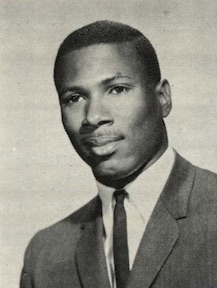
Sport: Tennis
Born: January 4,1947
Town: Elizabeth, New Jersey
Arthur A. Carrington, Jr. was born January 4, 1947 in Elizabeth, NJ. At the age of 10, Art learned to play at Elizabeth’s now-defunct North End Tennis Club, encouraged by his mother. In the 1950s, North End had two courts and functioned as a social hub for African-American professionals in central New Jersey. The club produced players who competed in the American Tennis Association (ATA), the “black” parallel to the powerful US Lawn Tennis Association. Sydney Llewellyn, who coached Althea Gibson, gave clinics there and was Art’s first coach. Gibson was the top-ranked player in the late-1950s.
Art attended Jefferson High in Elizabeth, which had a strong sports program. Among his classmates was Ron Freeman, a sprinter who won gold in the 1968 Olympics. Art started on the basketball team and distinguished himself in tennis as and one of the best junior competitors in the country, attending the nationals for the first time at the age of 15. He was undefeated as a junior and senior for the Minutemen and, in 1965, became the recipient of the first athletic scholarship offered by Hampton College in Virginia.
Hampton was part of the Central Intercollegiate Athletic Association, made up of historically black colleges. Art entered the CIAA tennis championships in the spring of his freshman year. He reached the finals, but lost to senior Joe Williams of NC Central. Art won the CIAA singles title each of the next three years and graduated in 1968.
Men’s tennis was by and large an amateur sport in the late-1960s, with the first US “Open” played a few months after Art’s graduation. Although trained to be a schoolteacher, he was determined to make a living in the sport he loved. The Westfield Indoor Tennis Club was looking to hire its first pro and Art got the job. He continued to compete in local tournaments and entered ATA events; in the early 1970s was regarded as America’s #2 African-American tennis player, behind Arthur Ashe. Art was known for his elegant strokes and exquisite footwork.
In 1972, Art played Horace Reid in the first-ever televised ATA singles championship, losing a close five-set match in Boston. The following year, Art won the ATA singles title. Technically, this should have resulted in an invitation to play in the US Open at Forest Hills—either in the main draw or in qualifying. A paperwork mix-up resulted in neither, drawing the attention of the press and putting the USLTA in a potentially tricky position. The problem was solved when a player dropped out of the main draw and Art was slotted into a first-round match-up against Ove Benyson, a big-serving veteran who played for Sweden’s Davis Cup team. Art fell in straight sets, playing on grass for the first time since 1966. His previous experience on grass came at the Orange Tennis Club as the guest of a white member.
In 1980, Art—a proponent of a “whole body” approach to tennis—opened his own academy, on the campus of Hampshire College in Massachusetts. Over the next four-plus decades, more than 3,000 students sharpened their skills under Art’s eye, and the eye of his son, Lex, who followed in his father’s footsteps. In 1985, Art caught the collecting bug, acquiring stacks of newspapers covering black tennis and ATA tournaments. His passion for research culminated in a traveling exhibit and short film created with the International Tennis Hall of Fame in Newport, RI and a book, published in 2009, entitled Black Tennis, An Archival Collection: 1890-1962.